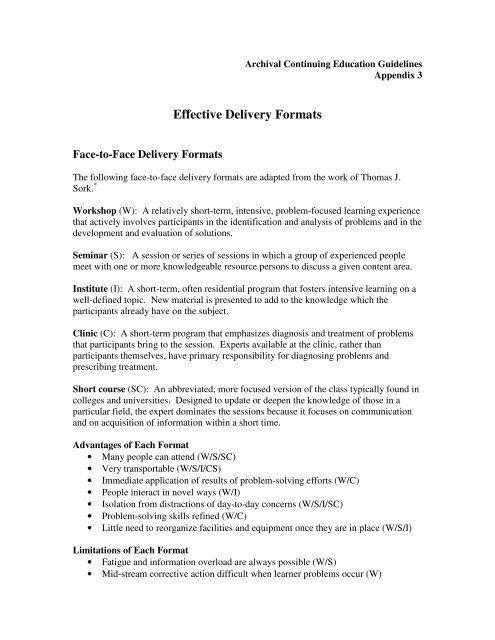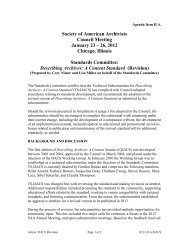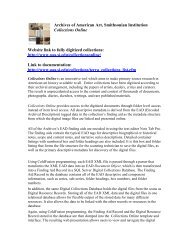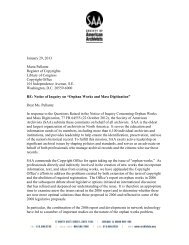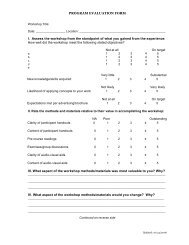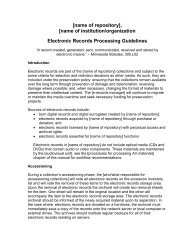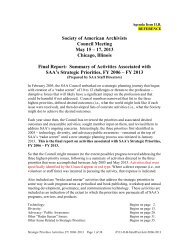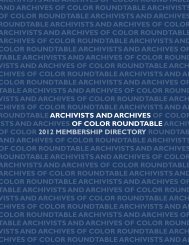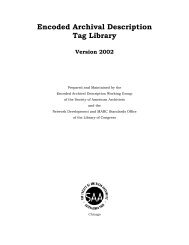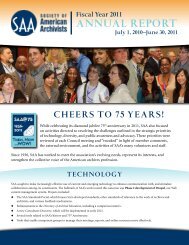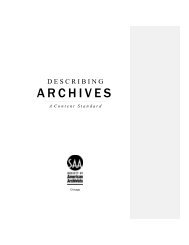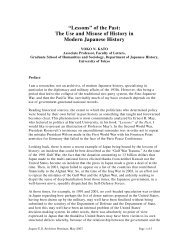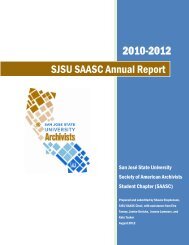Appendix 3
Appendix 3
Appendix 3
Create successful ePaper yourself
Turn your PDF publications into a flip-book with our unique Google optimized e-Paper software.
Archival Continuing Education Guidelines<br />
<strong>Appendix</strong> 3<br />
Effective Delivery Formats<br />
Face-to-Face Delivery Formats<br />
The following face-to-face delivery formats are adapted from the work of Thomas J.<br />
Sork. *<br />
Workshop (W): A relatively short-term, intensive, problem-focused learning experience<br />
that actively involves participants in the identification and analysis of problems and in the<br />
development and evaluation of solutions.<br />
Seminar (S): A session or series of sessions in which a group of experienced people<br />
meet with one or more knowledgeable resource persons to discuss a given content area.<br />
Institute (I): A short-term, often residential program that fosters intensive learning on a<br />
well-defined topic. New material is presented to add to the knowledge which the<br />
participants already have on the subject.<br />
Clinic (C): A short-term program that emphasizes diagnosis and treatment of problems<br />
that participants bring to the session. Experts available at the clinic, rather than<br />
participants themselves, have primary responsibility for diagnosing problems and<br />
prescribing treatment.<br />
Short course (SC): An abbreviated, more focused version of the class typically found in<br />
colleges and universities. Designed to update or deepen the knowledge of those in a<br />
particular field, the expert dominates the sessions because it focuses on communication<br />
and on acquisition of information within a short time.<br />
Advantages of Each Format<br />
• Many people can attend (W/S/SC)<br />
• Very transportable (W/S/I/CS)<br />
• Immediate application of results of problem-solving efforts (W/C)<br />
• People interact in novel ways (W/I)<br />
• Isolation from distractions of day-to-day concerns (W/S/I/SC)<br />
• Problem-solving skills refined (W/C)<br />
• Little need to reorganize facilities and equipment once they are in place (W/S/I)<br />
Limitations of Each Format<br />
• Fatigue and information overload are always possible (W/S)<br />
• Mid-stream corrective action difficult when learner problems occur (W)
• Teacher burnout (W/SC)<br />
• Little flexibility if timing is not maintained (W/SC)<br />
• Individual feedback to learners rarely possible (W/S)<br />
• Learners are not always effective participants (W/I/C/SC)<br />
Criteria for Selecting a Format<br />
• Learning objectives emphasize problem solving (W)<br />
• Solving problems that are relatively complex and generalized and that require<br />
intensive analysis (W)<br />
• Resources necessary to engage in problem solving are available where they can be<br />
effectively incorporated into workshop activities (W)<br />
• Skilled leadership is available (W/S/I/C/SC)<br />
• Participants come with, or can be provided with, the group process skills that they<br />
need to engage in effective problem solving (W)<br />
• Important to remove participants from their “natural” environment to bring about<br />
the desired changes in capabilities (W/I/C/SC)<br />
*Adapted from Sork, Thomas J. “The Workshop as a Unique Instructional Format.” In<br />
Designing and Implementing Effective Workshops, edited by Thomas J. Sork, pp. 3-10. San<br />
Francisco: Jossey-Bass, 1984.<br />
Distance Learning Formats<br />
Distance learning is training that takes place with registrants and instructors separated by<br />
locations and time zones. Registrants may receive materials and instructions for<br />
assignments via their computer or mail and are asked to return completed assignments to<br />
their instructor using the same media.<br />
Advantages of the Distance Learning Format<br />
• Allows registrants to take classes where and when they choose<br />
• Alleviates cost, time, and work constraints<br />
• Increases choices for more registrants<br />
• Doesn’t require a “brick-and-mortar” classroom<br />
• More suited to the mature adult learner<br />
Limitations of the Distance Learning Format<br />
• Requires more time and work to deliver than does face-to-face training<br />
• Registrants may feel isolated<br />
• Can be more of a challenge due to lack of structure and interaction with others<br />
• Administrative support needed may increase with larger number of registrants<br />
• Necessitates high start-up costs and longer time frame for recouping expense<br />
Criteria for Selecting the Distance Learning Format<br />
• Requires simple and direct writing by the instructor
• Activities and self-assessment exercises must be interspersed throughout, building<br />
to the end goal<br />
• Must be able to map a visible path when introducing the course in order to show<br />
registrant where he/she is at all times<br />
• Works best when concepts, ideas, and theories are repeated often<br />
Distance learning may be delivered using many techniques and technologies. E-learning<br />
is the distance learning form that uses the most “bells and whistles,” but there are other<br />
successful ways of delivering distance learning. These include the following:<br />
• E-learning is delivered via computers using internet technology and<br />
programming that allows registrants to interact with the materials via chat rooms,<br />
black boards, video conferencing, etc.<br />
• Recorded programming uses a series of pre-recorded programs designed to<br />
convey techniques and theory. Delivery via cable, tape, podcast, or DVD is most<br />
common.<br />
• Web seminars involve the use of a PC and telephone, allowing instructors to<br />
present a short program using a PowerPoint presentation and interacting with<br />
registrants via phone and email.


